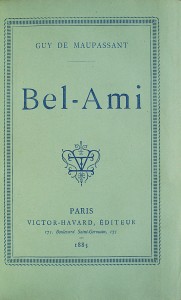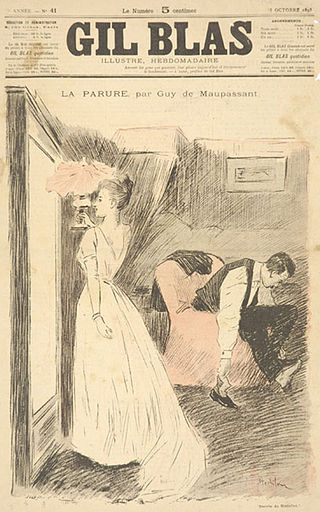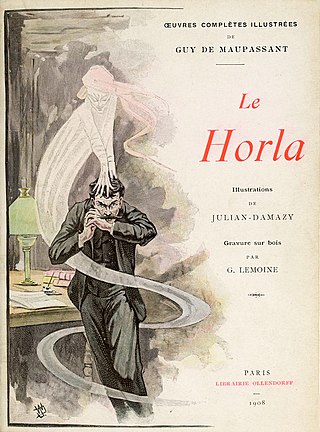Related Research Articles

Henri René Albert Guy de Maupassant was a 19th-century French author, celebrated as a master of the short story, as well as a representative of the naturalist school, depicting human lives, destinies and social forces in disillusioned and often pessimistic terms.

'Salem's Lot is a 1975 horror novel by American author Stephen King. It was his second published novel. The story involves a writer named Ben Mears who returns to the town of Jerusalem's Lot in Maine, where he lived from the age of five through nine, only to discover that the residents are becoming vampires. The town is revisited in the short stories "Jerusalem's Lot" and "One for the Road", both from King's story collection Night Shift (1978). The novel was nominated for the World Fantasy Award in 1976 and the Locus Award for the All-Time Best Fantasy Novel in 1987.
Clair de Lune is French for "Moonlight". It may refer to:

The Pays de Caux is an area in Normandy occupying the greater part of the French département of Seine Maritime in Normandy. It is a chalk plateau to the north of the Seine Estuary and extending to the cliffs on the English Channel coast; its coastline is known as the Côte d'Albâtre. In the east, it borders on the Pays de Bray where the strata below the chalk show through.

Bel-Ami is the second novel by French author Guy de Maupassant, published in 1885; an English translation titled Bel Ami, or, The History of a Scoundrel: A Novel first appeared in 1903.

"The Necklace" is a short story by French writer Guy de Maupassant. It is known for its twist ending, which was a hallmark of de Maupassant's style. The story was first published on 17 February 1884 in the French newspaper Le Gaulois.
"Paste" is a 5,800-word short story by Henry James first published in Frank Leslie’s Popular Monthly in December 1899. James included the story in his collection, The Soft Side, published by Macmillan the following year. James conceived the story as a clever reversal of Guy de Maupassant's "The Necklace".

"The Horla" is an 1887 short horror story written in the style of a journal by the French writer Guy de Maupassant, after an initial version published in the newspaper Gil Blas, October 26, 1886.
"The Wallet" is the 45th episode of the sitcom Seinfeld. It is the fifth episode of the fourth season of the series, and first aired on September 23, 1992. In this episode Morty's wallet goes missing from his trousers while at a back specialist's office, Jerry tries to conceal his having thrown away the watch Morty gave him, and George turns down his and Jerry's deal for a television pilot.

"Mademoiselle Fifi" is a short story by French writer Guy de Maupassant, published in 1882 in a collection of the same title. Like many of his short stories, such as Boule de Suif and Deux Amis, the story is set during the Franco-Prussian War and explores themes of class barriers, contrasts between the French and German participants, and the pointlessness of the war.

"Deux amis" or "Two Friends" is a short story by the French author Guy de Maupassant, published in 1882. The story is set in Paris during the Franco-Prussian War, when the city lay under siege. The story examines French bravery, German stereotypes and, unusually for Maupassant, discusses the nature and justification of war in the form of a conversation between the two protagonists.

Eugène Christophe was a French road bicycle racer and pioneer of cyclo-cross. He was a professional from 1904 until 1926. In 1919 he became the first rider to wear the yellow jersey of the Tour de France.

Mademoiselle Fifi is a collection of short stories by Guy de Maupassant published in 1882. The stories are:

Pierre et Jean is a naturalist or psycho-realist work written by Guy de Maupassant in Étretat in his native Normandy between June and September 1887. This was Maupassant's shortest novel. It appeared in three installments in the Nouvelle Revue and then in volume form in 1985, together with the essay “Le Roman” [“The Novel”]. Pierre et Jean is a realist work, notably so by the subjects on which it treats, including knowledge of one's heredity, the bourgeoisie, and the problems stemming from money.

Artine Artinian was a distinguished French literature scholar of Armenian descent, notable for his valuable collection of French literary manuscripts and artwork. He was immortalized as a fictional character by his Bard colleague Mary McCarthy in the novel The Groves of Academe (1952) and by his friend Gore Vidal in the play The Best Man (1960).

Le Rosier de Madame Husson is a novella by Guy de Maupassant, published in 1887. The hero is a young virtuous boy, the equivalent of a Rose Queen.
Guy de Maupassant wrote short stories, novels, travel accounts and poetry.

"Pierrot" is a short story by French writer Guy de Maupassant. It was originally published on 1 October 1882 in the French newspaper Le Gaulois. A year later, in 1883, it appeared in the short story collection Contes de la bécasse. The story was dedicated to Henry Roujon, novelist and public servant.
"La Bête à Maît' Belhomme" is a short story by French author Guy de Maupassant, published in 1885.
Afloat is an 1888 story by Guy De Maupassant. Ostensibly it is a logbook of a nine-day cruise along the côte d’Azur. The French original was given illustrations by Édouard Riou who the previous year had illustrated Alexandre Dumas' Le Comte de Monte-Cristo (1887), and would also illustrate Maupassant's Un soir (1889). These illustrations, as engraved by the Guillaume brothers, were also included in the English translation by Laura Ensor published by Routledge in 1889. A new translation by Douglas Parmée appeared in 2009.